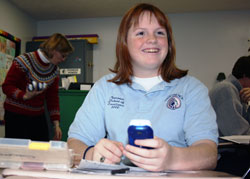Catholic Schools Week Supplement
High school students reap benefits of SMART technology

Alyssa Hendershot, a sophomore at Our Lady of Providence Jr./Sr. High School in Clarksville, holds a wireless device commonly known as a clicker that allows her to interact with classroom lectures and take tests. It is an element of SMART technology in four classrooms at Providence. Alyssa’s science teacher, Virginia Shirley, stands in the background and holds several more clickers. (Submitted photo)
By Sean Gallagher
Students in high school today have grown up in a time when computers and other digital equipment have been highly developed and have been a part of nearly every aspect of their lives.
So it’s not unusual for high school instruction in the archdiocese to adapt to this reality.
Our Lady of Providence Jr./Sr. High School staff members in Clarksville did this at the start of this academic year by installing self-monitoring, analysis and reporting technology (SMART for short) and software in four classrooms with plans to add it to more classrooms each year into the near future.
Other high schools’ staffs in the archdiocese, including Father Michael Shawe Memorial Jr./Sr. High School in Madison and Bishop Chatard High School, Cathedral High School and Brebeuf Jesuit Preparatory School, all in Indianapolis, have either already installed this technology in some or all of the classrooms or have plans to do so in the coming months.
SMART technology gives several advantages to teachers and students. It allows teachers to integrate videos, still images imported off the Internet or illustrations created by the teachers themselves and sound recordings into their classroom presentations.
Additionally, the technology allows teachers to make notes on images that are projected in the classroom.
“It’s old-time lecture gone high tech,” said Virginia Shirley, who uses SMART technology in her science classes at Providence High School.
Providence sophomore Patrick Gillenwater likes the usual classroom presentations enhanced with the SMART technology.
“I think it’s better for the students because you don’t just have the same old boring lecture,” Patrick said. “You get to actually do something else that involves learning, but with technology. I think it’s easier for the students.”
But more than simply allowing students to be passive consumers of an admittedly technologically dynamic lecture, SMART technology also lets them interact with teachers and take tests in a new way.
Each student has what is commonly referred to as a clicker that can help teachers quickly know if their students comprehend a particular point in a lecture.
“If I just want to see if the kids all have it, every child in class has the opportunity anonymously to input an answer—right or wrong—without fear of criticism,” Shirley said.
Students can also take tests with their clickers and know their grade immediately. Questions are projected on a screen and students can input their answers on their handheld wireless device.
For Providence sophomore Alyssa Hendershot, such quickness in learning how she did on a test is a relief.
“If I take a really big test, I’ll be stressed out, wondering what I got on it,” she said. “It’s definitely a lot easier because you don’t have that extra stress worrying about what grade you got and whether you did a good job or not.”
In addition to providing teachers and students with immediate test results, SMART technology also analyzes them according to several sets of criteria.
“There are about 20 different reports I can print out and look at for that data that is collected,” said Shirley. “It can be distributed by class, by individual students, by topic. I can link it to the standards for the state. It’s phenomenal.”
Joan Hurley, Providence’s president, said that the generosity of many supporters of the New Albany Deanery school, including some of its alumni, is responsible for the addition of SMART technology.
She said that such support is a sign of Catholic stewardship that makes Providence’s educational mission possible.
But more than simply bringing Providence High School into the 21st century, Hurley said that SMART technology helps maintain the school’s Catholic identity.
“Catholicism, from its roots, has always been about learning, about questioning, about seeking truth,” Hurley said. “And if all of those are true, then we should be using this technology to do that because it expands our world.” †
